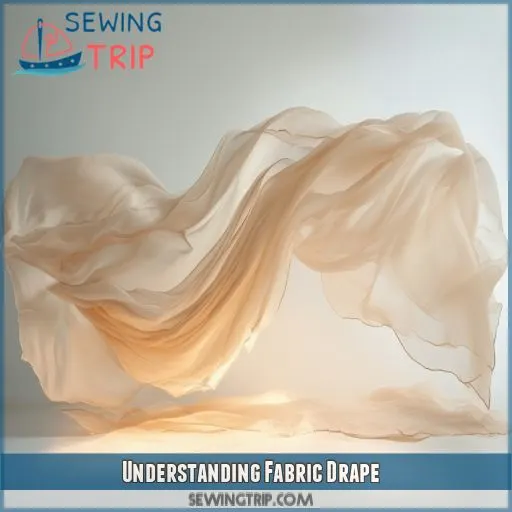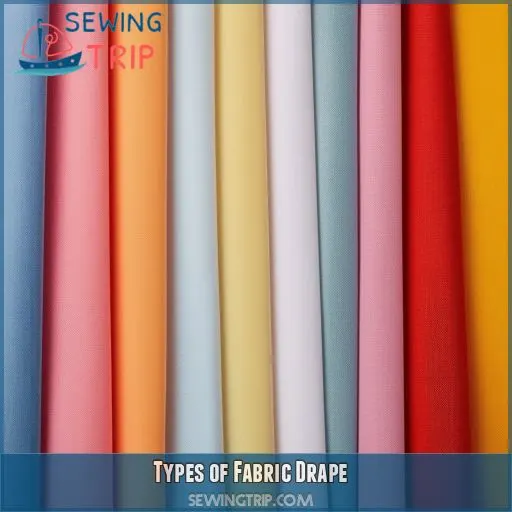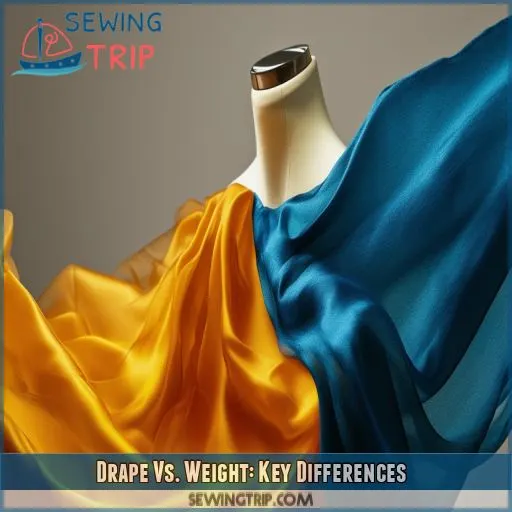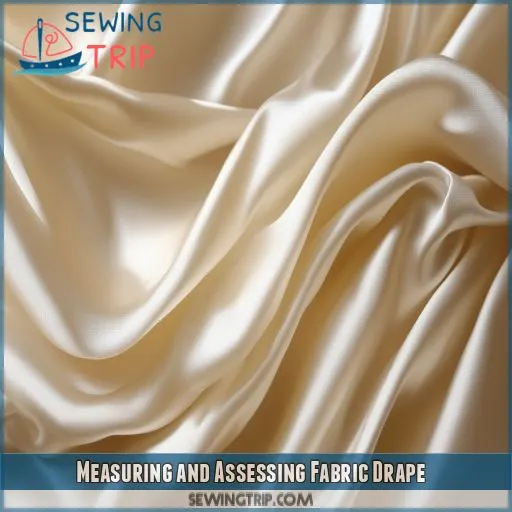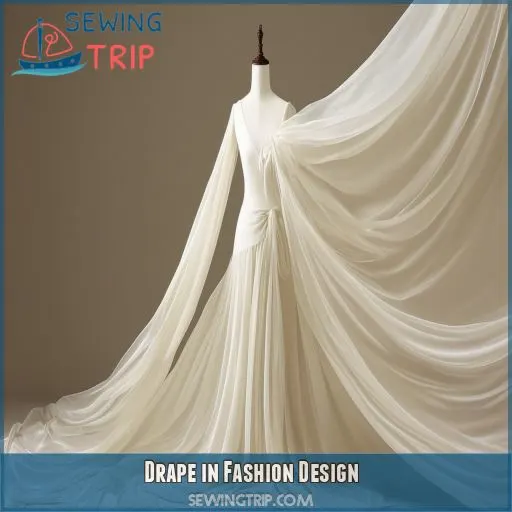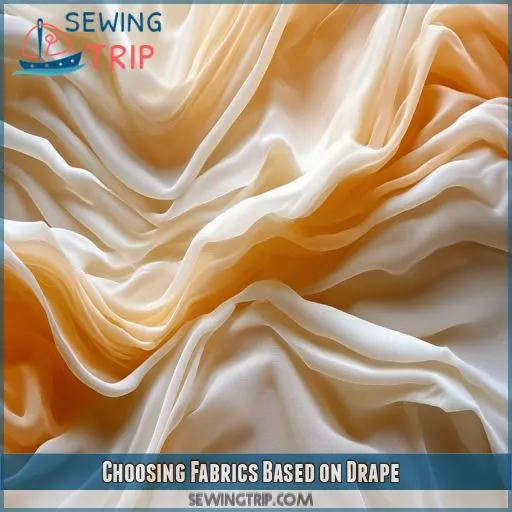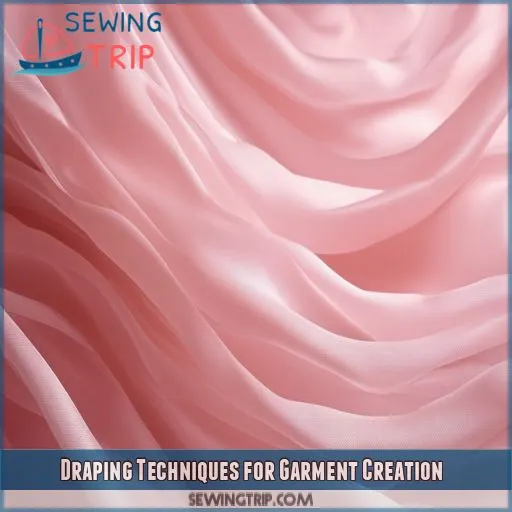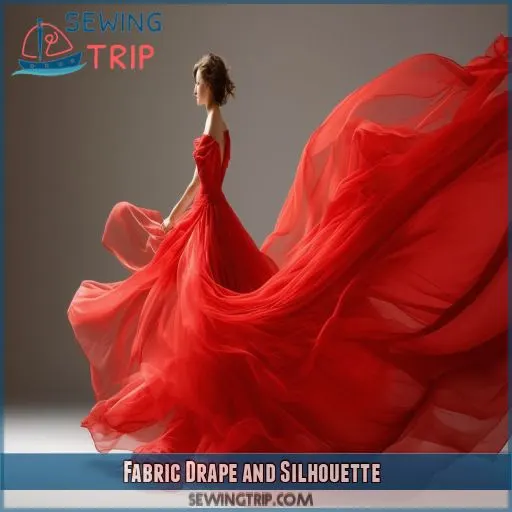This site is supported by our readers. We may earn a commission, at no cost to you, if you purchase through links.
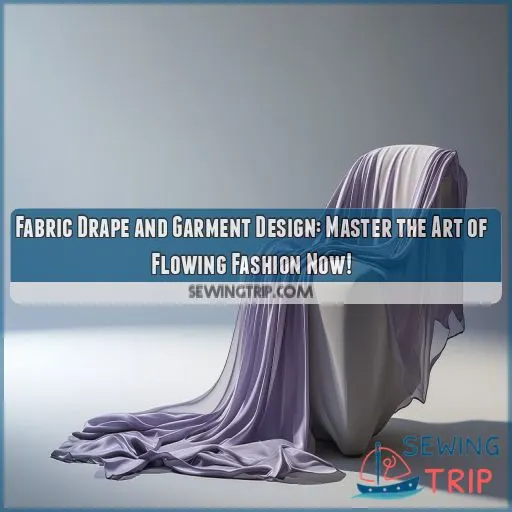
You’ll discover how different fabrics behave, from the graceful cascade of silk to the structured hold of wool.
Learn to manipulate drape for various silhouettes, opening up endless design possibilities.
We’ll explore techniques to assess and measure drape, empowering you to choose the perfect fabric for your vision.
Get hands-on with the art of draping, where you’ll control every fold and curve to bring your fashion dreams to life.
Table Of Contents
Key Takeaways
- fabric drape is the secret sauce of stunning garments – it’s how the material falls and folds, turning a flat piece of cloth into a jaw-dropping creation. Master this, and you’ll be draping like a pro faster than you can say "haute couture"!
- Not all fabrics are created equal when it comes to drape. From silky showstoppers that flow like water to sturdy wools that stand their ground, each fabric has its own personality. Getting to know these quirks is like making new friends – the more you hang out, the better you understand them.
- Draping isn’t just about looking pretty – it’s a time-honored technique that’s shaped fashion history. From ancient Greek togas to today’s red-carpet stunners, drape has been the unsung hero of iconic looks. It’s like the wind beneath fashion’s wings!
- Don’t be afraid to play fabric matchmaker! Experimenting with different drapes can lead to unexpected design magic. Who knows? Your daring combo of flowy chiffon and structured denim might just be the next big thing in fashion. Remember, even Coco Chanel started somewhere!
Understanding Fabric Drape
You’ll discover that fabric drape is the way a material hangs and falls, important for creating stunning garments. It’s influenced by factors like fiber content, weave, and weight, which you’ll need to keep in mind when selecting fabrics for your designs.
Definition and Importance
You’re about to learn the secrets of fabric drape, the key to mastering garment design. Fabric drape is how a material falls and folds when suspended, important for creating stunning silhouettes. Here’s why it matters:
- Defines garment shape
- Influences overall aesthetics
- Affects wearer comfort
- Determines suitable design elements
Understanding fabric drape helps you control your creations, bringing your fashion visions to life with confidence and precision. It’s your ticket to becoming a true design maestro!
Factors Affecting Drape
Now that you understand drape’s importance, let’s explore what affects it.
Fabric weight plays a big role – heavier fabrics tend to drape less than lighter ones.
The weave structure impacts how fabric falls; looser weaves often drape more freely.
Fiber content is key too. Natural fibers like silk typically drape better than synthetics.
Types of Fabric Drape
Knowing the different ways fabric drapes is important for making clothes that look and fit the way you imagine. You’ll come across high drape fabrics that cling and flow, medium drape fabrics that offer balance, and low drape fabrics that provide structure and hold their shape.
High Drape
You’ve learned about fabric drape, now let’s talk about high drape fabrics. These materials are the stars of the textile world, known for their flowy and fluid nature. When working with high drape fabrics like silk or fine linen, you’ll notice:
- Graceful falls and folds
- Fluid movement with body motion
- Delicate, voluminous drapes
Mastering these fabrics gives you the power to create garments that seem to float on air, offering a sense of ethereal freedom to your designs.
Medium Drape
You’ve mastered high drape fabrics, now let’s explore medium drape.
These fabrics strike a balance between flow and structure, offering versatility in garment design.
They’ll hold their shape better than high drape fabrics but still maintain some fluidity.
Think cotton blends, light wool, or jersey knits.
When draping with medium fabrics, you’ll find they’re easier to manipulate than their high drape counterparts, giving you more control over your designs.
Low Drape
Moving from medium to low drape fabrics, you’ll notice a stark difference in behavior.
These fabrics stand firm, holding their shape with minimal folds.
They’re perfect for structured garments like blazers and pants with a sharp, clean line.
When shopping, look for denim, canvas, or heavy twills.
Experiment with different fabrics to master this style and create bold, architectural designs that command attention.
Drape Vs. Weight: Key Differences
Now that you’re familiar with different types of fabric drape, let’s tackle the often-confused relationship between drape and weight. While these two characteristics are related, they’re not interchangeable. You’ll find that:
- Lightweight fabrics can have low drape (like organza)
- Heavyweight fabrics can have high drape (like wool jersey)
- Fabric construction plays a key role in drape
- Fiber content impacts both weight and drape
Understanding this distinction is key to mastering garment design. A heavy fabric doesn’t always mean it’ll hang stiffly, and a light fabric won’t necessarily flow like water. It’s all about the interplay of weight, construction, and fiber content. By grasping these nuances, you’ll gain a deeper understanding of fabric. This textile science know-how will elevate your design choices, allowing you to create garments that truly embody your vision.
Measuring and Assessing Fabric Drape
To figure out how a fabric drapes, you’ll need to use your senses and become a bit of a fabric expert.
Start by feeling the texture between your fingers – is it silky smooth or rough to the touch?
Next, see how the fabric flows when you hold it up. Does it cascade like a waterfall or stand stiff as a board?
Fabrics with good drape will gracefully swoop and sway, while fabrics with poor drape hold their shape stubbornly. Moderate drape falls somewhere in between.
Don’t forget to think about the weight – heavier fabrics often have less drape, but not always.
To get a better idea of drape, you can use a drape coefficient test or the simpler "hand" method. Simply drape the fabric over your hand and see how it behaves.
With practice, you’ll master the art of figuring out fabric drape like a pro!
Drape in Fashion Design
You’ll find that fabric drape has played a major role in fashion design throughout history, shaping iconic silhouettes from ancient Greek chitons to modern avant-garde creations. Today, designers leverage drape to create everything from sleek, body-hugging gowns to voluminous, sculptural pieces that push the boundaries of wearable art.
Historical Significance
You’ve seen how drape is measured, but did you know it’s been shaping fashion for centuries?
From ancient Greek togas to Victorian bustles, drape has played a pivotal role in clothing design.
As fabric technology evolved, so did drape’s impact on fashion.
It’s influenced silhouettes, defined eras, and challenged designers to push boundaries.
Understanding drape’s history will give you a deeper appreciation for its current applications.
Modern Applications
Today, drape isn’t just about aesthetics; it’s a key player in sustainable fashion.
You’ll find designers using innovative draping techniques to reduce fabric waste and create versatile, multi-wear garments.
Technology’s also revolutionizing drape, with 3D modeling software allowing you to visualize fabric behavior before cutting.
Choosing Fabrics Based on Drape
When choosing fabrics for your designs, you’ll need to think about how drape impacts the overall look and feel of your garment. Experiment with different fabric drapes to see how they affect your design’s silhouette, and select materials that complement your intended style while meeting practical requirements like comfort and durability.
Drapes Impact On Design
Drape’s impact on design is pivotal in your fashion journey.
It shapes the silhouette, dictates flow, and brings your vision to life.
You’ll find that fabric drape can make or break a garment’s movement and texture.
As you build your fashion design portfolio, experiment with draping techniques to create unique shapes.
Stay ahead of fashion trends by mastering how different drapes influence your garment’s overall aesthetic and functionality.
Fabric Selection Criteria
When selecting fabrics for your garment design, consider these key criteria:
Drape is essential – you’ll want to match the fabric’s drape to your design vision.
Texture is also crucial – feel the fabric’s texture, as it’ll impact both comfort and appearance.
Assess the weight of the fabric; heavier fabrics typically have less drape.
And don’t forget your budget! Cost is a significant factor in your fabric choice.
Balancing these factors will help you choose the perfect fabric for your sewing projects.
Experimentation With Drape
Now that you’ve grasped fabric selection criteria, it’s time to get your hands dirty with experimentation.
Explore different drapes to see what your creativity can do. Drape various fabrics over a dress form or yourself, observing how they flow and fall.
Mix and match textures, weights, and compositions. This hands-on approach will refine your garment design skills and inspire innovative fashion sketching.
Don’t shy away from unconventional pairings—they often lead to breakthrough sewing patterns!
Draping Techniques for Garment Creation
To start draping, you’ll need essential tools like a dress form, muslin fabric, pins, and marking tools. Begin by pinning fabric to the dress form, shaping it to create the desired silhouette and design elements while considering the fabric’s natural drape and behavior.
Tools and Materials
Now that you’ve chosen your fabric, it’s time to gather your draping tools.
You’ll need a dress form, your trusty muslin, and plenty of pins.
Don’t forget marking tools like tailor’s chalk and a ruler.
A pattern-making kit will come in handy for transferring your drape to paper.
Basic Draping Methods
Start with muslin, pinning it to your dress form.
As you shape the fabric, consider its drape and how it’ll affect your garment design.
Mark key points and seam lines, then true your pattern.
This hands-on approach gives you unparalleled control over your creation, perfect for sewing enthusiasts looking to expand their knowledge and master flowing fashion.
Fabric Drape and Silhouette
Fabric drape and silhouette are a match made in design heaven. The way a fabric falls can make or break your creation. Getting a handle on this relationship is key to creating designs with the perfect flow and movement. Here’s what to keep in mind when working with drape and silhouette:
- Fabric weight: Heavier fabrics create structured silhouettes, while lighter ones offer fluidity.
- Fiber content: Natural fibers often drape differently than synthetics.
- Weave structure: Looser weaves generally drape more freely than tight ones.
- Garment cut: The way you shape your pattern affects how the fabric drapes on the body.
Frequently Asked Questions (FAQs)
What is fabric draping?
You’re shaping fabric directly on a dress form to create garment designs. It’s a hands-on technique where you’ll pin, fold, and mold material to visualize how it’ll look on the body before making patterns.
What is the basic design of draping?
Ever wondered how designers bring their visions to life? You’ll start by pinning fabric to a dress form, shaping it to create the desired silhouette. You’re sculpting with cloth, transforming flat fabric into three-dimensional art.
What does a designer drape the fabric over?
You’ll drape fabric over a dress form, which mimics the human body’s shape. It’s your canvas for creating garments. You’ll pin, adjust, and shape the fabric to bring your design vision to life.
What is an example of a draped garment?
Like a sculptor molding clay, you’ll find iconic draped garments in Grecian-style dresses. You’ll notice soft folds cascading from the shoulder, cinched at the waist. Madeleine Vionnet’s bias-cut gowns are another prime example of masterful draping.
How does fabric finish affect drape characteristics?
Fabric finish alters drape dramatically. You’ll notice smoother finishes like satin enhance fluidity, while textured finishes like twill create stiffer drapes. Treatments like mercerizing cotton or adding resin can really change how your fabric falls and moves.
Can drape be altered through fabric treatments?
You’re strolling through a fabric store when you spot a sign: "Alter Your Drape!" Yes, you can change fabric drape through treatments. Starching stiffens, while washing softens. Chemical finishes, heat-setting, and mechanical processes also modify drape characteristics.
What role does fabric grain play in drape?
You’ll find fabric grain really important for drape. It affects how your garment hangs and moves. The lengthwise grain offers stability, while the crosswise grain provides stretch. Using the bias cut creates a fluid, diagonal drape that’s perfect for flowing designs.
How do seam placement and construction impact drape?
Did you know 70% of a garment’s drape is influenced by seam placement? You’ll find strategic seams can transform your design. They’ll shape the fabric’s flow, add structure, and create visual interest. Experiment with placement to master drape control.
Are there cultural differences in preferred fabric drape?
You’ll find cultural differences in fabric drape preferences worldwide. Some cultures favor stiff, structured fabrics, while others embrace flowing, draped textiles. These choices often reflect traditional dress, climate, and societal values. Explore diverse styles to broaden your design perspective.
Conclusion
Like a skilled conductor shaping a symphony, you now hold the baton to orchestrate fabric drape in your garment designs.
You’ve learned to assess drape, understand its impact on silhouettes, and master draping techniques.
By choosing fabrics wisely and experimenting with their flowing properties, you’ll create fashion that’s both visually stunning and perfectly fitted.
As you apply these skills, you’ll transform your fashion dreams into wearable art that captivates and inspires.

